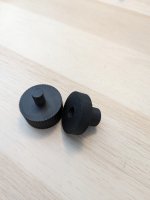Packard
Member
NOTE: I (consistently) used “carpenters’ square” when I meant “framing square”. Those corrections have been made below Packard.
Not that, but I do want to see another product.
To date, I have produced three MFT-type table tops. I used a peg board as a template, along with a Vix bit, to locate the holes.
In each table top there is one hole that is out of alignment (and never in the same spot).
Here is what I would like:
A dog that would allow me to hold acarpenters’ framing square securely to the table top (three pieces would be needed). Then I can use the carpenters’ framingsquare for squareness and not depend on the hole placement.
Ideally the dogs would hold thecarpenters’ framing square about 3/16” above the surface. That would provide a better height for clamping.
NOTE: I would clamp the work pieces to the table, but use the square to maintain squareness. I would not clamp down on themcarpenters’ framing square itself.
So as long as mycarpenters’ framingsquare is dead on at 90 degrees, the hole alignment will not be critical.
This would be useful for many applications, but a shoe in for making face frames using pocket screws.
Carpenters’ framing squares come in a variety of thicknesses, so I am not sure how you would design it. (Or if it is even feasible.)
I can’t imagine that my table tops are the only ones out there with alignment/squareness issues. Currently I have used a Magic Marker to circle the offending holes. I just pick a different spot.
In any case, relying on acarpenters framing square for squareness seems more reliable than relying on the MFT tops.
I hope this is useful. I’d be glad to test the beta design.
I would note that not allcarpenters’ framing squares are perfectly square either. I test them before using them. I like the aluminum ones because they are thicker.
Good luck
Not that, but I do want to see another product.
To date, I have produced three MFT-type table tops. I used a peg board as a template, along with a Vix bit, to locate the holes.
In each table top there is one hole that is out of alignment (and never in the same spot).
Here is what I would like:
A dog that would allow me to hold a
Ideally the dogs would hold the
NOTE: I would clamp the work pieces to the table, but use the square to maintain squareness. I would not clamp down on them
So as long as my
This would be useful for many applications, but a shoe in for making face frames using pocket screws.
I can’t imagine that my table tops are the only ones out there with alignment/squareness issues. Currently I have used a Magic Marker to circle the offending holes. I just pick a different spot.
In any case, relying on a
I hope this is useful. I’d be glad to test the beta design.
I would note that not all
Good luck







